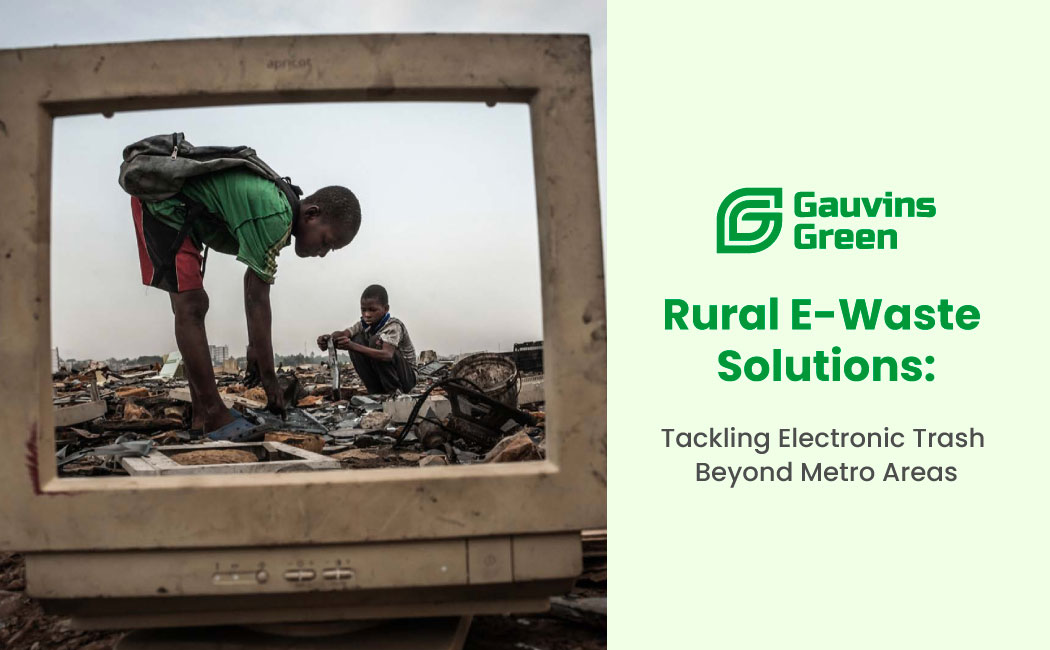|
Getting your Trinity Audio player ready...
|
From the lung-clearing smogs of Beijing to radiation seeping out from nuclear plants, pollution is one of the defining environmental crises of the 21st century and a huge challenge for our planet´s ecology. From air to water, from soil, the environment is being polluted in an unprecedented manner. Technology has been a boon for the human race, but this same advancement of technology has led to the creation of huge volumes of E-waste and pollution in the environment. Gauvins Green Joined the Leading E-waste recycling company in Delhi to beat this issue by providing inventive e-waste service and e-waste recycling solutions that address air, water, and soil contamination.
This blog post will try to understand Gauvins Green’s multi-dimensional process for pollution prevention by sustainable processes in e-waste management and analyze the approach to combat air, water, and soil pollution during these processes.
Table of Contents
ToggleUnderstanding Pollution
Definition of Pollution
Pollution is the introduction of contaminants into the natural environment that cause adverse changes. The pollutants are gases, liquids, and solids in nature which come out of different source forms like industrial output, vehicle emissions or people helplessly dumping rosin old electronics centers.
Causes of Pollution
The Primary Polluting Factors The leading causes of pollution are now quite clichéd and stem from industrial effluents, garbage dumping, overuse of fossil fuels, deforestation, and the increasing pile of e-waste. Take e-waste as an example, because it includes toxic heavy metals such as lead, mercury, and cadmium that will if not handled correctly eventually pollute the air, water, and soil.
The Gauvins Green Approach
Overview of the Approach
In the combined approach that Gauvins Green and better waste management have in place for reducing pollution, community engagement is essential. Teach the youths, so they can go to their local communities and inform residents of what not to do when it comes to improper e-waste disposal and offer practical solutions that enable someone willing to help them properly handle e-waste. Local recycling programs are encouraged, which would keep a portion of the e-waste out of landfills and from being sent abroad.
Key Components
Gauvins Green’s approach includes:
- Collection: Efficient collection of electronic waste from households and industries.
- Segregation: Sorting and e-waste segregation to isolate toxic materials from recyclable parts.
- Recycling: Using advanced recycling management techniques to recover valuable materials, minimizing the need for new raw materials.
- Education and Awareness: Engaging communities in sustainable practices through educational programs and initiatives.
Impact on Air Quality
Strategies for Air Pollution Reduction
Most of the times, e-waste are burnt in open spaces which results in the emission of toxic gases like dioxins and furans resulting in air pollution. By providing certified recycling facilities, Gauvins Green helps prevent air pollution by circumventing the incineration of electronic waste. Promoting e-waste recycling prevents these harmful chemicals from being released into the atmosphere
In addition to this, the cooperative also works with local businesses on ways of e-waste recycling disposal that will be emission-reducing. The company reduces the need for incineration, in which 85% of the plastic is burned and released into the atmosphere all over Switzerland with modern recycling technologies.
Case Studies/Examples
One of the better-known initiatives driving this collaboration for air quality is Gauvins Green, which has partnered with small-scale electronics manufacturers in Delhi. Although one cannot say that e-waste no longer affects the environment, providing them with custom-made solutions for the disposal of e-waste has, at the very least, helped reduce open-air burning practices leading to an improved air quality and a more harmonious home to nature.
Impact on Water Quality
Strategies for Water Pollution Reduction
If e-waste is not e-waste disposed of properly, this can lead to the leaching of hazardous chemicals into water bodies ultimately contaminating rivers, lakes, and groundwater. Gauvins Green follows a high e-waste segregation method to avoid water contamination in the wrong way from harmful chemicals like mercury and lead which are kept isolated and treated separately.
Their recycling facilities are also provided with advanced water treatment systems to avoid harmful discharge in nearby water bodies while e-waste recycling. In addition, Gauvins Green encourages sectors and communities to act responsibly in discarding their end-of-life electronic products to avoid improper dumping…one of the leading contributors to water pollution.
Case Studies/Examples
Over the next few years, when e-waste contamination emerged as a rising problem in their local water bodies, Gauvins Green started their first project in collaboration with the Delhi Water Board (DJB) in 2023. Through community recycling initiatives and by making it easier to drop off old electronic items, they were able to save more than 10 tons of toxic e-waste from leaching into waterways.
Impact on Soil Quality
Strategies for Soil Pollution Reduction
Improper landfill disposal of electronic waste can be a source of soil contamination with toxic metals leaching into the ground. This Gauvins Green helps reduce soil pollution by preventing e-waste from being dumped in landfills. Instead, they concentrate on efficient e-waste recycling management to extract valuable metals and safely dispose of hazardous substances.
By stressing the need for segregation of E-waste, they prevent the hazardous chemicals from mingling with recyclable elements and hence maintain an unstained soil. Gauvins Green transforms the environment by educating and advocating for responsible e-waste disposal, and recycling so that soil is not invaded with toxic pollutants that inhibit its quality which in turn affects plant life.
Case Studies/Examples
One of Gauvins Green’s successful projects involved reclaiming contaminated soil from an industrial landfill in Delhi. Through a combination of soil decontamination methods and community engagement, the project restored 15 acres of land previously affected by improper e-waste disposal practices.
Community Engagement
Importance of Community Involvement
Community engagement plays a vital role in Gauvins Green’s multi-faceted approach to pollution reduction. By educating local communities about the dangers of improper e-waste disposal and offering practical solutions, they empower individuals to participate in e-waste management efforts. Communities are encouraged to take part in local recycling programs, thereby reducing the amount of e-waste that ends up in landfills or is improperly discarded.
Programs and Initiatives
Gauvins Green runs various programs and initiatives through which workshops, seminars, and public awareness campaigns are organized to educate people regarding the significance of e-waste recycling. Their “Green Delhi” makes schools, businesses, and households the focus of their e-waste collection drives to guarantee an effective system for disposal and recycling. Also, they work with government agencies to set policies for responsible disposal of e-waste. As a result, there has been greater community engagement and a significant reduction in local pollution levels due to these programs. Challenges and Solutions
Challenges and Solutions
Identifying Challenges
Despite the progress made, Gauvins Green faces several challenges in its efforts to reduce pollution through e-waste recycling. The biggest hurdle is the lack of awareness among the general public and industries about the dangers of improper e-waste disposal. Additionally, the informal e-waste recycling sector in Delhi, where workers lack proper safety measures, poses another challenge.
Proposed Solutions
To address these challenges, Gauvins Green is working to expand its educational initiatives, aiming to reach more people through digital campaigns and community outreach programs. They also advocate for stricter regulations and better enforcement of existing laws regarding e-waste management. Collaboration with informal recyclers is another key solution, as Gauvins Green offers training programs to ensure safe and responsible recycling practices.
Conclusion
Gauvins Green has taken an all-encompassing and sustainable approach to minimize air, water, and soil pollution using efficient mechanism of e-waste management. With the focus put on e-waste segregation, e-waste recycling, and community driving, we maintain proper disposal of electronic waste to mitigate its despicable effects on our environment. Gauvins Green is reducing pollution and using sustainability in innovative ways to help reach a cleaner, greener tomorrow.
As a major e-waste recycling company in Delhi NCR, Gauvins Green is conscious of their role in providing safe and responsible recycling services for all forms of Electronics recycling which not only protects the environment but offers considerable economic returns as well. Gauvins Green will strive to create a world less impacted by the pollution of electronic waste through continuous public education, industry collaboration, and partnerships with the government. Gauvins Green is making its way into a future without the harmful effects of pollution from electronic waste.




